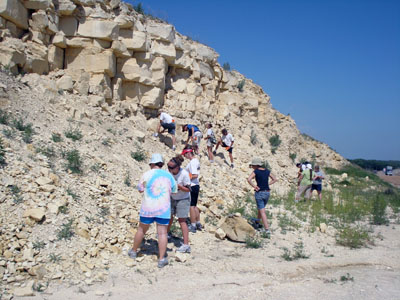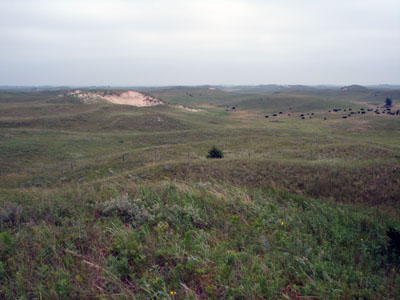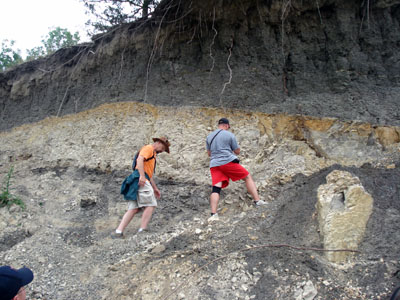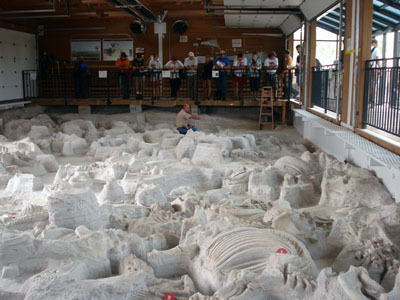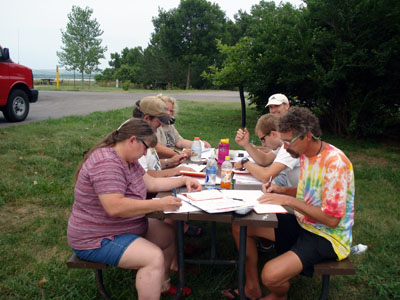Monday July 21 - Introduction to Earth History
9 AM – 3 PM: Classroom lecture and lab activities to provide background on sedimentary rocks and Earth history. Department of Geosciences, University of Nebraska-Lincoln city campus.
4 PM – Departed Lincoln. Traveled to Rock Creek Station State Historical Park near Fairbury, NE. Camped overnight.
Tuesday July 22 - Cretaceous Seas
Stop 1: Starr Quarry*, located along Hwy 8 between Endicott and Rudy, NE. Exposure of Cretaceous Dakota Group.
Stop 2: Rose Creek roadcut, located ~6 miles south of Fairbury along Hwy 15. Exposure of Cretaceous Dakota Group.
Stop 3: Rose Creek Quarry*, located ~6 miles south of Fairbury along Hwy 15. Exposure of Cretaceous Dakota Group.Stop 4: Roadside exposure of Cretaceous Graneros Shale, located along Hwy 15, just north of the NE-KS border.
Stop 5: Roadside exposure of Cretaceous Greenhorn Limestone, located along KS Hwy 36 east of Cuba, KS.
Stop 6: Roadside exposure of Cretaceous Niobrara Chalk, located along KS Hwy 36 east of Mankato, KS.
Continued west on KS Hwy36, then north on HWY 281. Camped overnight at Mormon Island State Recreational Area near Grand Island, NE.
*Denotes site on private property. These sites may only be accessed with prior permission from the owners.
Stop 3: Teachers search for fossils of early angiosperms (flowering plants) in an old quarry that exposes coastal deposits of the Dakota Formation.
Stop 6: Teachers examine chalks that formed in a Cretaceous seaway that ran north-south, from the Arctic Ocean to the Gulf of Mexico. The chalk consists of tiny fossils of planktonic algae, nannfossils.
Tuesday July 22 - Nebraska Sand Hills and a Cretaceous Tsunami
Stop 1: Roadside exposure of Pleistocene Peoria Loess at mile marker 100, north of St. Paul on Hwy 281.
Stop 2: Climbed a large dune that affords a view across the eastern edge of the Sand Hills at mile marker 127, near the junction of Hwys 281 and 91 East.
Stop 3: Examined a blowout in sand dune at junction between Hwys 281 and 91 West. Did some digging and discovered some gopher burrows.
Stop 5: Niobrara State Park, exposures of the Cretaceous Pierre Shale near the park entrance and along the Missouri River. River exposure included a 2-mile roundtrip hike along an old rail line and a climb up a vegetation-covered slump block to see the unusual Crow Creek Member of the Pierre Shale.
Stop 2: View over the Nebraska Sand Hills along Hwy 281. The Sand Hills are derived from glacial outwash eroded from the Rockies, and now stabilized by vegetation.
Stop 5: Two teachers examine a 74 million year old tsunami deposit preserved in an outcrop of the Cretaceous Pierre Shale. The tsunami was generated by a meteorite impact. The meteorite fell into the shallow sea that covered what is now northwest Iowa. The crater formed by the impact, the Manson Impact Structure, now lies buried beneath the land surface. It was discovered during the drilling of water wells.
Wednesday July 23 - Volcanic Fallout in Nebraska
Stop 1: Ashfall Fossil Beds State Historic Park off Hwy 20, north of Royal, NE. Toured the museum and rhino barn. Had an overview of the geology and paleontology of the Miocene Ogallala Group.
Stop 2: Grove Lake State Wildlife Management Area. “Chalk Mountain” mystery exposure, which turned out to be a volcanic ash deposit.
Stop 3: Roadside exposure of Miocene Valentine Formation (part of Ogallala Group), located along Hwy 59, just west of the crossing with Verdigre Creek. Collected fossils.
Stop 4: Roadside exposure of the Cretaceous Pierre Shale, the site of a recent Plesiosaur find that lies within the boundaries of the Santee Sioux Nation near Center, NE.
Stop 5: Returned to Niobrara State Park to finish up geologic timelines.
Stop 1: Teachers view skeletons exposed in a ~12 million year old bed of volcanic ash at Ashfall Fossil Beds SHP near Orchard, NE. Superintendent Rick Otto points out the fossil skeletons of the more than 200 mammals found here, including one species of rhinocerous, 5 species of horses, and 3 camel species.
End of the day: Teachers finish up their field notes and work on constructing timelines that depict the geological history of Nebraska.
Thursday July 24 - Return to the Present
After a morning summary lecture, we packed up and travelled back to the present.
